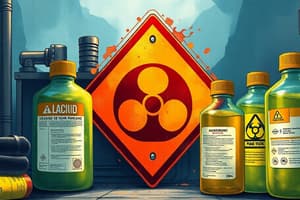Podcast
Questions and Answers
What materials were primarily used in the creation of Archaic sculptures?
What materials were primarily used in the creation of Archaic sculptures?
- Marble, bronze, and clay (correct)
- Metal, fabric, and clay
- Wood, clay, and bronze
- Limestone, plaster, and stone
Which of the following is a distinctive feature of Archaic sculptures?
Which of the following is a distinctive feature of Archaic sculptures?
- Rigid posture and the Archaic smile (correct)
- Dynamic movement and asymmetry
- Soft, flowing forms
- Naturalistic details and realism
What do the terms Kouroi and Korai refer to in Archaic art?
What do the terms Kouroi and Korai refer to in Archaic art?
- Portraits of historical figures
- Reliefs depicting mythological scenes
- Statues of idealized male and female figures (correct)
- Statues representing deities in temples
What characterized the Classical period of Greek art?
What characterized the Classical period of Greek art?
What was the primary purpose of sculptures created during the Archaic period?
What was the primary purpose of sculptures created during the Archaic period?
Which characteristic was NOT emphasized in Archaic sculptures?
Which characteristic was NOT emphasized in Archaic sculptures?
In what way did Kouroi and Korai differ in their representation?
In what way did Kouroi and Korai differ in their representation?
What crucial role did Archaic sculptures play in Greek culture?
What crucial role did Archaic sculptures play in Greek culture?
What was one of the primary practical uses of pictograms among the Ancient Sumerians?
What was one of the primary practical uses of pictograms among the Ancient Sumerians?
How did pictograms evolve over time?
How did pictograms evolve over time?
What role did pictograms play in early communication?
What role did pictograms play in early communication?
What material was primarily used for classical Greek sculptures?
What material was primarily used for classical Greek sculptures?
Which statement reflects the cultural significance of pictograms?
Which statement reflects the cultural significance of pictograms?
What modern influence can be traced back to the use of pictograms?
What modern influence can be traced back to the use of pictograms?
Which technique was employed for creating bronze sculptures?
Which technique was employed for creating bronze sculptures?
What emotional qualities characterized Hellenistic period artworks?
What emotional qualities characterized Hellenistic period artworks?
How did classical Greek art reflect the cultural pride of city-states?
How did classical Greek art reflect the cultural pride of city-states?
What was a common subject matter expansion in Hellenistic Greek art?
What was a common subject matter expansion in Hellenistic Greek art?
What pottery techniques were commonly used in classical Greek art?
What pottery techniques were commonly used in classical Greek art?
What characterized the dynamic and realistic sculptures of the Hellenistic period?
What characterized the dynamic and realistic sculptures of the Hellenistic period?
What type of emotional states did Hellenistic sculptures often portray?
What type of emotional states did Hellenistic sculptures often portray?
What was a significant impact of Alexander the Great's conquests on Hellenistic art?
What was a significant impact of Alexander the Great's conquests on Hellenistic art?
What feature is notable in the complex compositions found in classical Greek art?
What feature is notable in the complex compositions found in classical Greek art?
What is Plato's perspective on art as described in his work 'The Republic'?
What is Plato's perspective on art as described in his work 'The Republic'?
Which concept did Aristotle introduce regarding the impact of art on audiences?
Which concept did Aristotle introduce regarding the impact of art on audiences?
What was Aristotle's belief about art's role in moral education?
What was Aristotle's belief about art's role in moral education?
How did Plato's view on art differ from Aristotle's regarding emotional influence?
How did Plato's view on art differ from Aristotle's regarding emotional influence?
What did Plato prefer over art in society?
What did Plato prefer over art in society?
Which aspect of art did Plato argue could lead individuals away from virtue?
Which aspect of art did Plato argue could lead individuals away from virtue?
What is the philosophical term used by Aristotle for art representing human life?
What is the philosophical term used by Aristotle for art representing human life?
In what way did Plato's Allegory of the Cave relate to his views on knowledge and reality?
In what way did Plato's Allegory of the Cave relate to his views on knowledge and reality?
What was Aristotle’s view on the pleasure derived from art?
What was Aristotle’s view on the pleasure derived from art?
Which of the following best describes the reason Plato banished poets from his ideal city-state?
Which of the following best describes the reason Plato banished poets from his ideal city-state?
What natural sources are pigments derived from in miniature paintings?
What natural sources are pigments derived from in miniature paintings?
Which period is noted for achieving the zenith of medieval craftsmanship in manuscript illumination?
Which period is noted for achieving the zenith of medieval craftsmanship in manuscript illumination?
What was one of the primary uses of illuminated manuscripts during church services?
What was one of the primary uses of illuminated manuscripts during church services?
How did the collaboration between scribes and illuminators impact manuscript production?
How did the collaboration between scribes and illuminators impact manuscript production?
Which of the following is an example of a devotional aid found in illuminated manuscripts?
Which of the following is an example of a devotional aid found in illuminated manuscripts?
What was a significant outcome of the artistic techniques developed in illuminated manuscripts?
What was a significant outcome of the artistic techniques developed in illuminated manuscripts?
What symbolized wealth and status during medieval times regarding illuminated manuscripts?
What symbolized wealth and status during medieval times regarding illuminated manuscripts?
In miniature paintings, what does intricate detailing often represent?
In miniature paintings, what does intricate detailing often represent?
What role did illuminated manuscripts play in the preservation of knowledge?
What role did illuminated manuscripts play in the preservation of knowledge?
What was a key purpose of the colors and pigments used in miniature paintings?
What was a key purpose of the colors and pigments used in miniature paintings?
Flashcards are hidden until you start studying
Study Notes
Pictograms
- Ancient Sumerians used pictograms in trades, marking pathways, and locating resources.
- Pictograms evolved into more abstract and stylized symbols, forming the foundation for cuneiforms and hieroglyphics.
- They served as a universal mode of communication in trades, travel, and cross-cultural interactions.
- Other cultures developed their own pictograms, such as Native American imagery of animals, humans, and celestial bodies.
- Pictograms laid the groundwork for more sophisticated writing systems, transitioning from concrete pictorial to abstract symbols.
- They continue to influence contemporary design, conveying information quickly through signage, wayfinding, and user interfaces.
- Pictograms played a crucial role in early communication, especially in societies with limited literacy, serving to record history.
- Their visual forms have influenced modern graphic design.
- Pictograms were integral in preserving cultural knowledge, stories, and histories.
- They reflected societal values, spiritual beliefs, and ways of life of various cultures.
Ancient Greek Art
- Covers the period from 800 BCE to 31 BCE.
- Includes major periods: Archaic, Classical, and Hellenistic.
- Notable for its idealized human forms, religious themes, and emphasis on balance and harmony.
Archaic Period (800 - 480 BCE)
- Characterized by rigid postures with arms at the sides.
- Often featured the "Archaic Smile," signifying life and vitality.
- Included Kouroi (male) and Korai (female) sculptures dedicated as votive offerings in sanctuaries.
- Utilized geometric patterns.
Classical Period (480 - 323 BCE)
- Represents a high point in artistic achievement.
- Focused on balance, idealization, and the representation of the human form.
- Artworks were commissioned for temples and sanctuaries as offerings to the gods.
- Sculptures depicted deities and heroes of Greek mythology.
- Materials used included marble (primarily), limestone, bronze, and clay for pottery.
Hellenistic Period (323 - 31 BCE)
- Characterized by significant cultural, political, and artistic changes due to Alexander the Great's conquests.
- Emphasized emotional expression and dynamic, realistic sculptures.
- Subject matter expanded beyond Greek mythology and heroes to include ordinary people and exotic subjects.
- Painting and pottery remained important artistic expressions.
Medieval Illuminated Manuscripts
- Developed during the Romanesque and Gothic periods (Middle Ages), reaching a zenith in monastic scriptoria.
- Created by artisans with specialized expertise in writing and artistry.
- Contained religious texts, including Bibles, Psalms, and Book of Hours.
- Used for liturgical purposes, devotional practice, and education.
- Visual elements helped convey complex ideas and contributed to their prestige.
- Commissioning an illuminated manuscript was a sign of wealth and status.
- Their artistic heritage influenced subsequent movements, such as the Renaissance.
- The division of labor between scribes and illuminators resulted in a collaborative process.
- Illuminated manuscripts were valuable for preserving knowledge, including religious texts, philosophical treatises, historical records, and literary works.
Studying That Suits You
Use AI to generate personalized quizzes and flashcards to suit your learning preferences.




